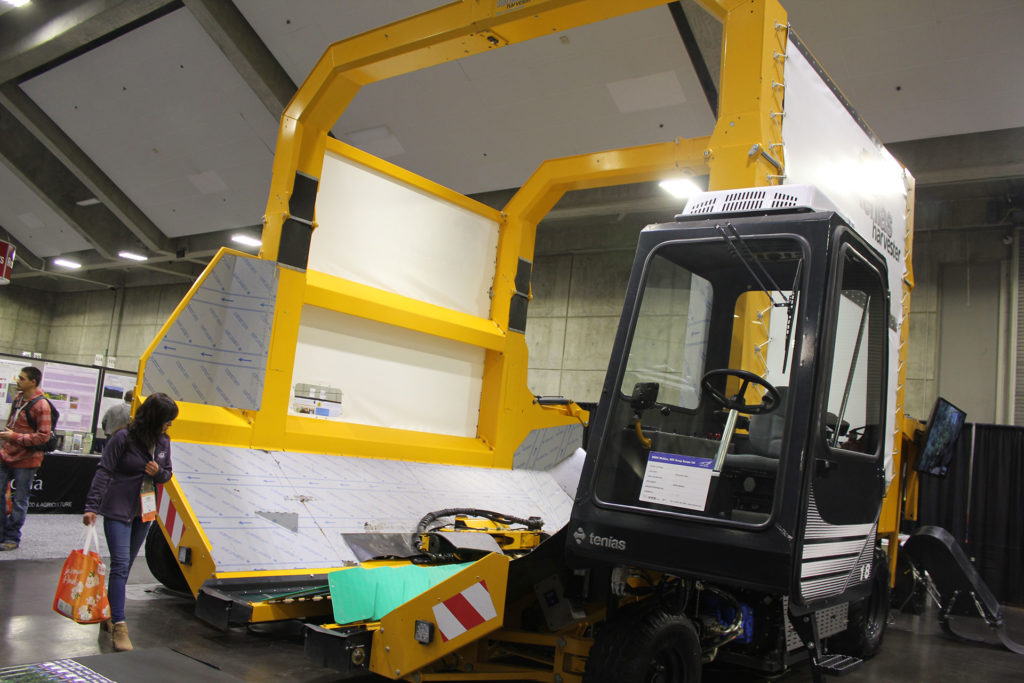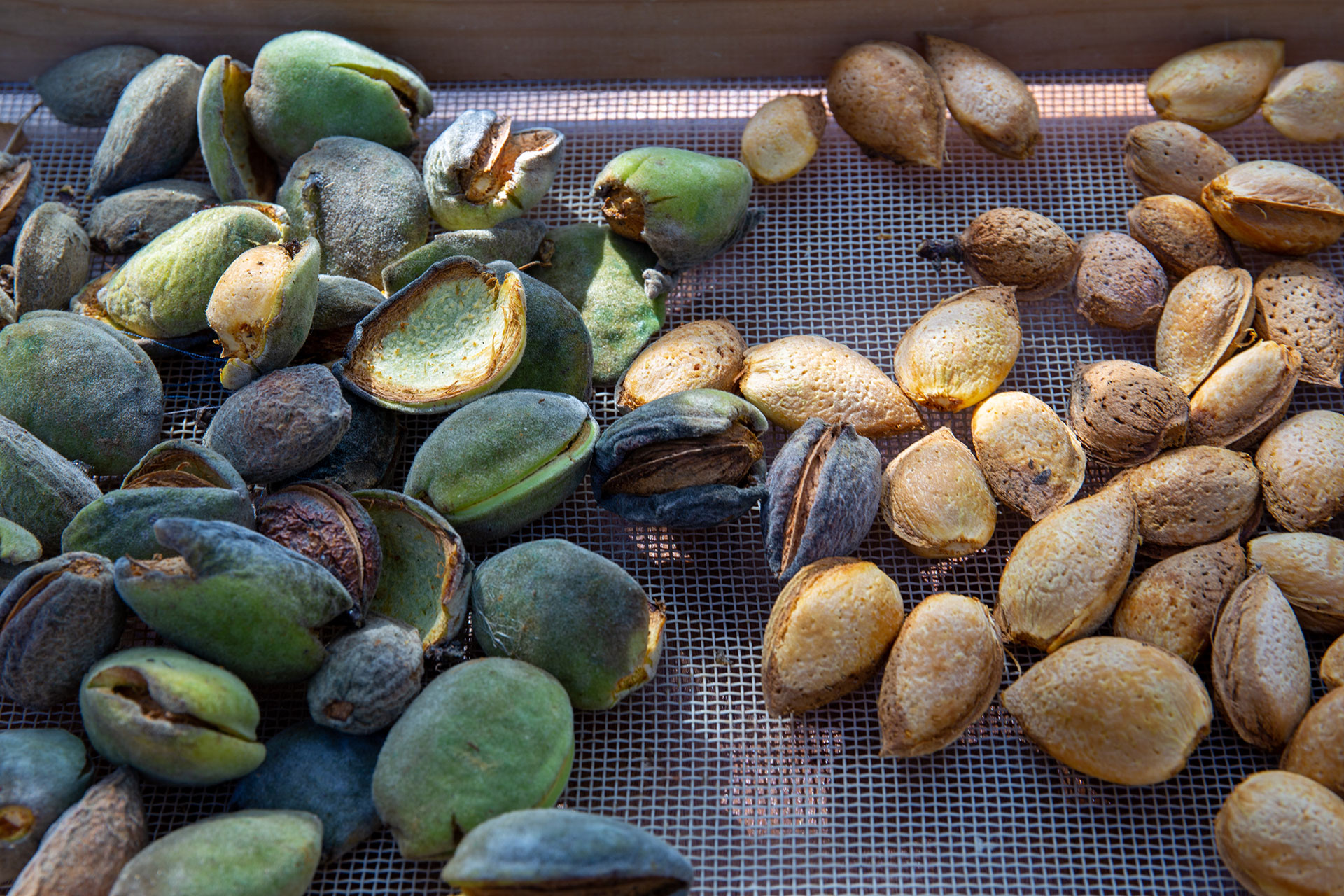Alternative Harvesting Practices
Josette Lewis, the Almond Board of California’s (ABC) new Director of Agricultural Affairs predicted exploring alternative harvesting options will be a journey for almond growers as they make decisions and evaluate the advantages and disadvantages of what would be a major change for the industry. The topic of advanced harvest is so intriguing that it is one of the opening topics at The Almond Conference 2019 in December.
While other almond-producing countries have adopted some alternative harvest practices, including over the top harvest, in recent years, nearly all of the California crop, that makes up 80 percent of the world’s almond production, is harvested by first mechanically shaking, then windrowing the nuts and finally scooping them up with a pickup machine. New technology in harvest equipment and new harvest strategies have been successful in reducing the amount of dust generated during harvest operations, but dust remains an issue for the industry and is one of the drivers for alternative harvest.
Lewis said ABC funded research will help growers understand their harvest options. She noted that some growers are already trying new approaches to harvest and equipment manufacturers are also exploring changes in harvest machine design.
Grower Driven Changes
Changes will be grower driven, Lewis predicted, as growers strategize to improve their harvest efficiency, reduce dust and improve orchard health.
Advancing harvest dates, using a catch frame to keep nuts off the ground and mechanical drying are all aspects of almond harvest that are being studied.
Lewis said that adoption of these practices have the potential to also change orchard design, pest management and cultural practices. There will certainly be trade-offs. Mechanical drying would use energy, but early and off the ground harvest would also reduce aflatoxin and crop damage due to pests or disease.
Research
The level of interest in advanced harvest among almond growers is high, confirmed Patrick Brown of the UC Davis Plant Sciences Department.
Growers see the harvest alternative as one way of meeting the California almond industry’s 2025 Goal of harvest dust reduction.
Brown sees plenty of challenges in adoption of advanced harvest by the almond industry, but the environmental benefits may outweigh the challenges in the future. There could be increased flexibility in irrigation scheduling, meaning less tree stress at the critical time of bud development. Cover crops could replace bare orchard floors, providing extra soil health and pollinator habitat. There is also the chance of reduced need for pesticide applications if nuts are harvested earlier.
Advanced Harvest Entails
Advanced harvest entails removal of nuts from the orchard shortly after maturity. Reducing the amount of time open, mature nuts are on the tree or orchard floor reduces exposure to navel orangeworm, hull rot and aflatoxin. There is also the potential for enhanced tree health and management. Advancing harvest would allow for timely irrigation at bud development. Avoiding water stress at that time could improve next year’s yields. Earlier removal and avoiding on-ground contact would give growers options in floor management, weed control and ant and vertebrate pest control.
There is also the food safety aspect. Eliminating contact with the ground reduces contamination.

Shake and Catch
With shake and catch harvest, Brown said on-farm hulling could be an option, but more research is needed. There is a challenge with soft shell varieties. One interim step suggested would be to transport the nuts off-site for spreading and drying. Mechanical hulling onsite would require new machinery.
Additional machinery and drying costs could cut into a grower’s bottom line. New infrastructure may be necessary with equipment and harvest date change. There is also a possible impact of machine drying on nut quality and yields.
Methods and consequences of in-field hull return and incorporation are also unknowns with advanced harvest.
Shake and Catch Trial
A shake and catch trial with an OMC Magnum Catchall showed positive results in a fifth leaf orchard, Brown said. There was some spilling of nuts in trees over 15 feet in height, and he noted that tree crotches need to be higher as current shake and catch equipment is not designed for 24 inch crotch height. Poor positioning of the shoe can also cause loss of nuts due to limited operator experience. The operation is also slower, shaking only 20 trees per hour compared to 60 with conventional equipment. This could be offset by the single pass needed compared to three to four with conventional harvest.
Other Options
Other existing options for harvest include modified grape harvest machines, over the top machines and wrap around harvest machine.
Brown said trials showed the modified grape harvest machinery is hard on trees with possible lasting effects. The over the top, manufactured by Tenias in Spain, and exhibited at The Almond Conference 2018 performed well with some positives. Brown said the moving shaker head appeared to be efficient and the skirt conforms easily around the tree trunk. He also noted the machine is too heavy to be used on clay soils and there are concerns about excessive spur pruning.
Brown said some possible cultural and environmental benefits to advanced off ground harvest are still being evaluated.
Those include postharvest tree health and greenhouse gas mitigation.
Research Priorities
Advanced harvest research priorities named by Brown include:
- Early harvest mechanics, with a focus on shaker practice and technology
- Catch frame design
- Hulling
- Drying
In biology and horticulture, research is needed in tree management for optimal shaking, timing, quantifying disease and tree health benefits, maturity and nut quality, hull breakdown and impact on nutrient dynamics, soil health and greenhouse gas dynamics, water use, economics and cost/benefit analysis.
Long term research priorities include:
- Tree architecture and orchard design with size controlling rootstocks
- Grafting
- Pruning and tree density
- Planting design with cultivars in row or self fertile varieties
- Precision harvest
Brown said critical questions about advanced and off ground harvest to be answered are:
- Will this harvest method work in all California almond environments, cultivars, age and planting designs?
- What does this harvest method mean for future tree architecture and orchard designs?
- Will size-controlling rootstocks be desired?
- What will be the spacing need?
Finally, the net benefits and costs must be considered.












